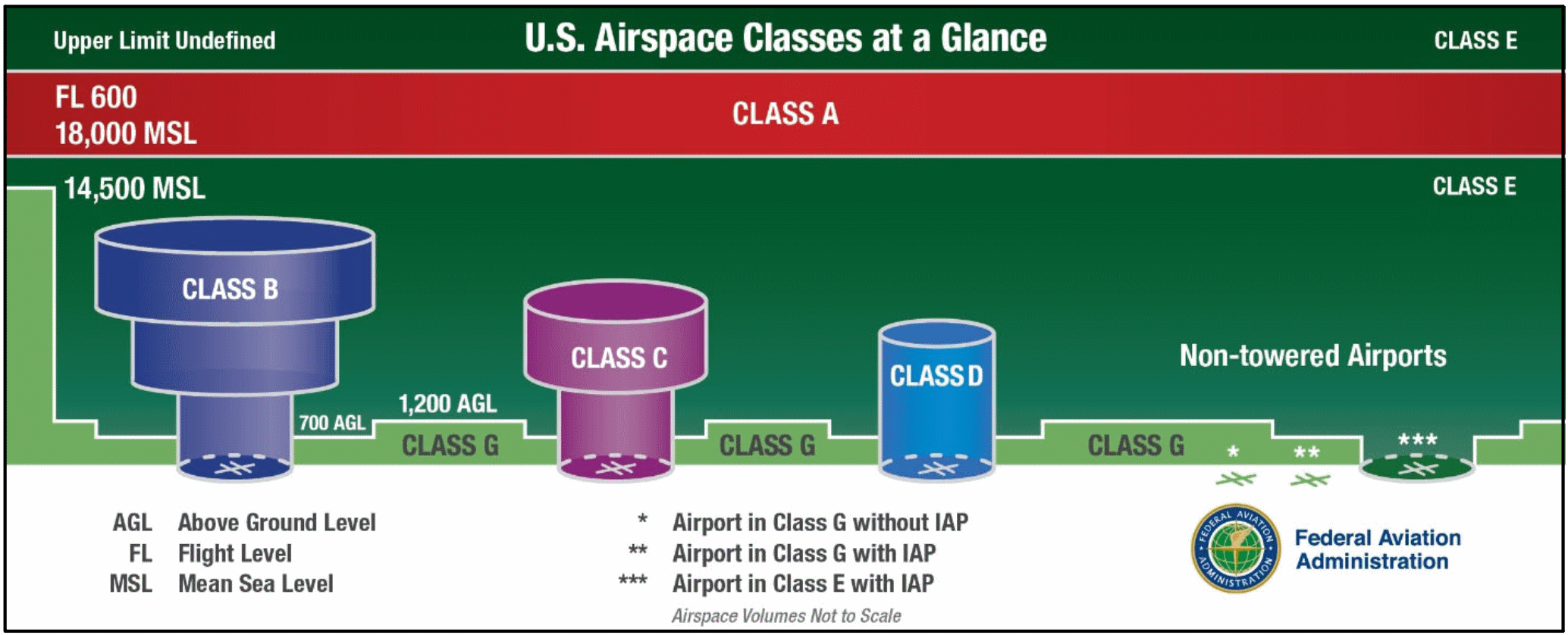class g airspace weather minimums
Class G Is The Most Lenient And Confusing. It usually isnt though.
Here is what to know.
. To fly in Class G airspace you will need a minimum of a student pilot certificate. When flying into an airport in Class G airspace communications should be established prior to 4 NM from the airport up to and including 2500 AGL. Cloud Clearance Standard VFR Minima means 3 SM visibility 500 ft.
In class B airspace ATC separates both IFR and VFR aircraft from other IFR and VFR aircraft. Above and 2000 ft. What are the Basic VFR Weather Minimums for Class G airspace.
That can be a good idea. Class G 1200 to 10000 ft. Rules governing VFR flight have been adopted to assist the pilot in meeting the responsibility to see and avoid other aircraft.
A Unless otherwise specified in the certificate holders operations specifications when conducting VFR helicopter air ambulance operations in Class G airspace the weather minimums in the following table apply. When you understand that the minimums and the corresponding altitudes make sense. VFR Minimum Distance from Clouds Below 10000 MSL.
This is truly uncontrolled airspace. Class G surface to 1200 ft Day. The weather minimums in Class G airspace vary based on altitude whether it is day or night and proximity to an airport.
A Except as provided in paragraph b of this section and 91157 no person may operate an aircraft under VFR when the flight visibility is less or at a distance from clouds that is less than that prescribed for the corresponding altitude and class of airspace in the following table. Depending on how high you fly and the time of day within Class G airspace your visibility requirement could range anywhere from 1SM to 5SM. 135609 VFR ceiling and visibility requirements for Class G airspace.
The VFR weather minimums are the same as Class C airspace 3 SM with a ceiling of at least 1000ft and cloud clearance of 1000ft above 500ft below and 2000ft horizontally. So you dont have to stay at 600 AGL forever and you can legally fly over congested areas at 1000 AGL just fine. Day - 1 Statute Mile.
Minimum flight visibility and distance from clouds. Above 1200 feet AGL but below 10000 feet MSL during the day. Made in establishing the basic VFR weather minimums is that aircraft flying at lower altitudes ie below 10000 MSL andor in airspace with radar approach control andor an operating control tower ie Class B C and D airspace will be moving more slowly or that they will be under positive control.
36 rows 91155 Basic VFR weather minimums. Class E airspace is controlled airspace which is not Class A B C or D. Basic VFR Weather Minimums.
I am looking at the weather requirements for Class G operations and I cant seem to find an airport or airspace that would be Class G above 1200 feet. Class G airspace uncontrolled is that portion of airspace that has not been designated as Class A Class B Class C Class D or Class E airspace. Night - 3 Statute Miles.
Cloud clearance minimums of 1000 feet above 1000 feet below and 2000 feet horizontally. Because of this there isnt enough room for all VFR aircraft to be 1000 above 500 below or 2000 horizontally from the clouds and ATC be able to separate them from. No person may operate an aircraft under basic VFR when the flight visibility is less or at a distance from clouds that is less than that prescribed for the corresponding altitude and class.
Cloud clearances range from clear of clouds to 1SM There are 6 sets of Class G weather minimums associated with various altitudes during the day or night. A Except as provided in paragraph b of. A Unless otherwise specified in the certificate holders operations specifications when conducting VFR helicopter air ambulance operations in Class G airspace the weather minimums in the following table apply.
This is for your crop dusters your powered gliders and the uncontrolled airports around the country. I guess what I am asking is if there is an airport that is Class G at the surface outside of any other airspace where does the Class G end and where does the Class E begin. It is the most complex airspace for weather minimums as it not only has 3 altitudes it also has daynight minimums.
135609 VFR ceiling and visibility requirements for Class G airspace. Classes A through E VFR Weather Minimums Class G VFR Weather Minimums. See VFR Weather Minimums.
As far as launching on a cross-country trip in class G airspace remember that youll eventually be in an area where class G goes up to 1200 AGL. What are the Basic VFR Weather Minimums for Class E airspace. 91155 Basic VFR weather minimums.
Related Article Special VFR Clearance Explained. Clear of clouds Night. 10000 feet MSL or higher.
And Class E is more restrictive than Class G airspace. Class D airspace is more restrictive than Class E or Class G airspace. Horizontal clearance of clouds.
Consequently these aircraft do not. Class G will not be depicted on the charts.

Airspace Classes And Special Use Airspace Everything There Is To Know
How To Remember Vfr Weather Minimums Bobbie Lind
How To Remember Vfr Weather Minimums Bobbie Lind
How To Remember Vfr Weather Minimums Bobbie Lind
How To Remember Vfr Weather Minimums Bobbie Lind

This Is How Class G Airspace Works Boldmethod

Helicopter Instrument Procedures Part Three

Pa I E S1 Vfr Weather Minimums Youtube
Regulations Vfr Minimums Learn To Fly Blog Asa Aviation Supplies Academics Inc
Vfr Weather Minimums Cancel Ifr Darren Smith Flight Instructor Cfi Homepage

This Is How Class G Airspace Works Boldmethod

Far Part 135 Sec 135 609 Effective As Of 04 22 2015
What Are The Basic Vfr Minimums Quora




